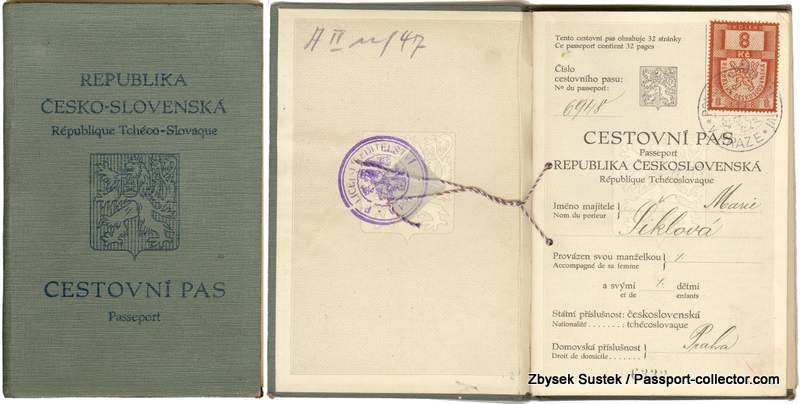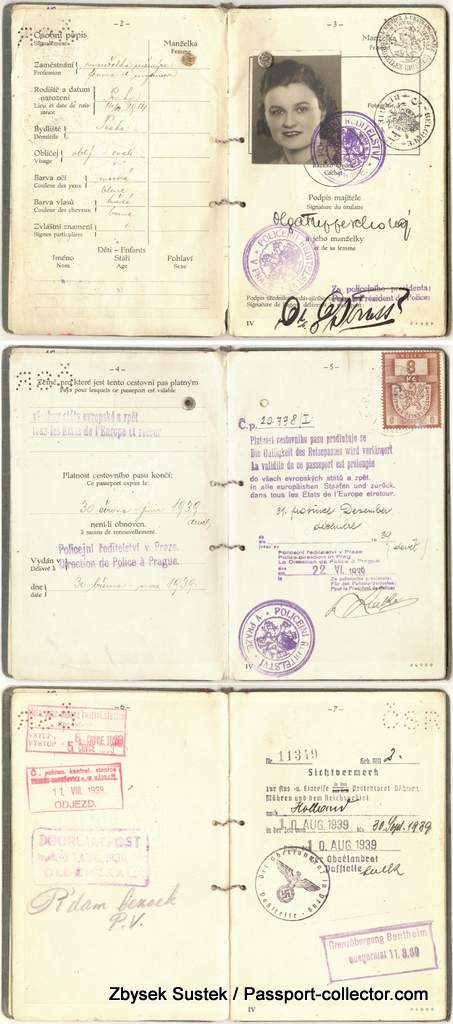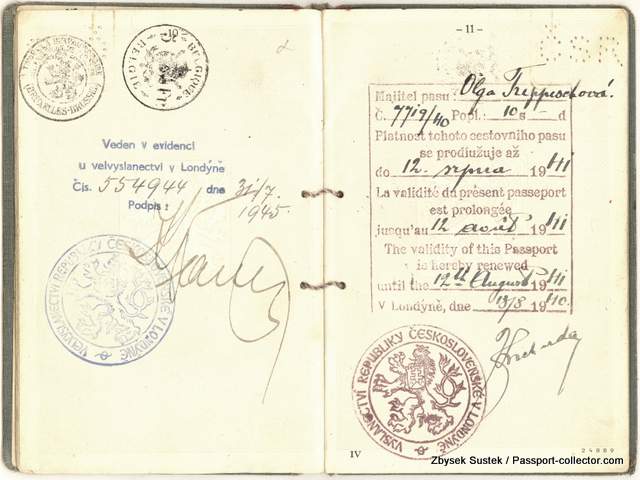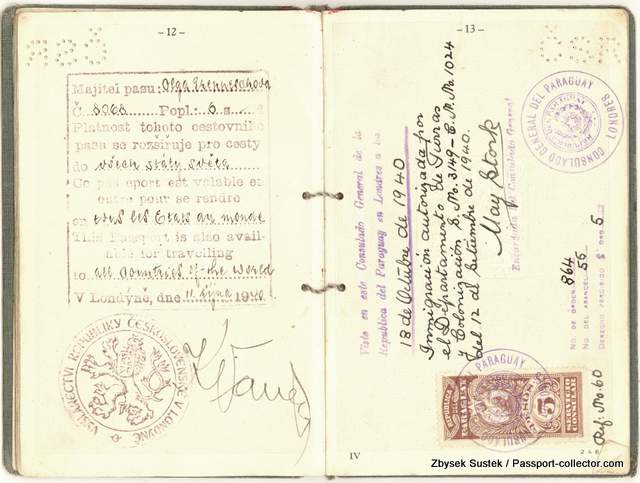A unique Bohemia and Moravia Passport 1939
Text and pictures by Zbyšek Šustek Bohemia Moravia Passport
Just one day after the Nazi’s occupation of the rest of Bohemia and Moravia, the Czechoslovak Ministry of Foreign Affairs was dissolved on 16 March 1939. All Czechoslovak embassies were to be immediately conveyed to the German Reich and their archives and inventory. Germany overtook the complete external representation of the Protectorate. However, Hitler’s occupation decree accepted the issued Czechoslovak passports as interim passports. The former Czechoslovak authorities, being transformed in the “autonomous” administration of the Protectorate, were temporarily allowed to continue issuing passports. These passports could be used for traveling only with a special permit (Sichtvermerk) given for concrete travel by the local occupation authorities (Landrat). Bohemia Moravia Passport
The newly issued passports were modified. Inscriptions on the front desk and the first page were professionally covered by stickers declaring the country’s new position as a part of the German Reich (Fig. 1-4). The passports of the model of 1938 were used for this purpose. The earlier issued passports of different types could also be modified in this way on the holder’s demand, but their modifications were improvised and variable (Fig. 3). Bohemia Moravia Passport




The Germans tolerated autonomous issuing of the interim passports approximately until summer 1939. The last issued passport, known to the author, was issued on 4 August 1939. Although the newly issued or additionally modified Czechoslovak passports are relatively abundant, only very few of them had been used for traveling, even if their holder got the traveling permit, for example, for the summer holiday 2-3-week trip to Yugoslavia. Thus most of them reflect the atmosphere in the first months of the Nazis’ occupation when many people still hoped that the situation should not be so bad. No of them was later “modified” back to the Czechoslovak passport.
An exception is this passport (Fig. 4-6) issued by the Police Direction in Prague to Mrs. Olga Treppeschová, a 25 years old wife of an engineer, on 30 March 1939 with a 3-month validity for all European countries. Its validity was prolonged from 22 June to 31 December 1939. On 5-6 June, Mrs. Treppeschová made a one day trip, probably to the Sudetes, the area ceased to Germany after the Munich Agreement, passing the border checkpoint Chrášťany near Týn nad Vltavou in South Bohemia. On 10 August, she got the German travel permit to the Netherlands for 10 August – 30 September 1939 (Fig. 6 below right). Already next day, probably in the morning on 11 August, she left the Protectorate by a train passing through the railway checkpoint Terezín Bohušovice (northerly of Prague on the railway to Berlin) and still on 11 August she entered the Netherlands through the checkpoint OLDENZAAL (Fig. 6 bellow left). Bohemia Moravia Passport

On 25 August, she asked for a Belgian visa in Rotterdam and got it on 13 September (Fig. 5-7). In Brussels, she paid a tax of 5 Belgian franks for stamping her passport with a special Belgian seal. There are no marks about continuing her travel to France. Still, she obviously stayed there and contacted the Czechoslovak embassy at Paris, which had not been over-given to the Germans, and continued its activity in service of the emerging resistant movement and emigrants. On 25 May 1940, the embassy corrected her passport back to the Czechoslovak passport (Fig 5). Without any notes in her passport, she left for London, where the Czechoslovak embassy prolonged her passport validity from 13 August 1940 until 12 August 1941 (Fig. 8 right). On 10 October 1940, she enlarged it for all countries of the world (Fig. 10). Bohemia Moravia Passport



Obviously, she stayed in France and later in England with an invalid passport for several months. She registered her stay in London as late as 21 August 1941 and the alien registration office on the Picadilly square (Fig. 11). Bohemia Moravia Passport
During her stay in England, on 25 October 1940, she got a French visa to visit Vichy, where she had to meet her husband (Fig. 9 left upper). But it is unclear whether she really traveled there. In October – December 1940, she gradually obtained the transit visa of Spain, Portugal, and Argentina (Fig. 9) to travel to Paraguay, where she obtained the immigration permit on 12 December 1940 (Fig. 10). Obviously, she could not or did not undertake this travel and remained in England. She got the visa almost five months after the defeat of France, signing the armistice on 22 June 1940 and splitting into a directly occupied zone and a “free” zone under the government of Marshal Petain. Spain and Portugal remained neutral, but they were friends of Germany… Thus, the secure transport possibilities to Paraguay were probably minimal.


Her stay in England was anew registered by the Czechoslovak embassy still on 31 July 1945, when the validity of her passport was prolonged to 31 December 1945 (Fig. 11).

Where and how she spent the period, 1941 – 1945, is unclear. However, she appears together with her husband on the list by the Social Wealth Ministry of the Czechoslovak Exile Government at London of holocaust survivors (No. 107 and 108) to be repatriated to Czechoslovakia on 13 – 14 August 1945 (Fig. 12). Several photographs inserted in her passport show that she was alive and obviously in excellent condition still in late 1967. Details of her later destiny are, however, unknown. Bohemia Moravia Passport

Her family name included in the survivor’s list reveals that she and/or her husband could be Jews. But it is unsure because she appears in two photographs with the note Christmas 1938 and 1967, hence a Christian fest possibly respected in a mixed marriage. However, in any case, she followed the example of many Jews, who succeeded to emigrate from Czechoslovakia already before the Nazis occupation or did it make legally shortly after the occupation, when the Jews still were not registered, and the anti-Semitic and migration policy of Nazis was still benevolent, as described in the book “Tourist against my own will” by Adolf Hoffmeister. She also followed examples of Jews who migrated to South America with the help of different semi-legal bodies, as excellently documented in the recently appeared book “Passports, police, and profiteers.” Bohemia Moravia Passport
The modification of her “protectorate” passport back to the Czechoslovak passport is a unique improvised solution. It was obviously motivated by the effort of the embassy staff to economize the available reserves of the blank passport booklets and help as many emigrants as possible. For this reason, the filled passports were also enlarged by insets of 12 pages. The shortage in the new passport blanks in the active Czechoslovak embassies was solved in 1944 by printing, at Bradbury and Wilkinson in England, new passports as an almost perfect imitation of the earlier ones, but in Czech-French-English language mutation. However, despite this, the pre-war passports were still issued after the war by the embassy in Paris. Bohemia Moravia Passport
FAQ Passport History
Passport collection, passport renewal, old passports for sale, vintage passport, emergency passport renewal, same day passport, passport application, pasaporte passeport паспорт 护照 パスポート جواز سفر पासपोर्ट
1. What are the earliest known examples of passports, and how have they evolved?
The word "passport" came up only in the mid 15th Century. Before that, such documents were safe conducts, recommendations or protection letters. On a practical aspect, the earliest passport I have seen was from the mid 16th Century. Read more...
2. Are there any notable historical figures or personalities whose passports are highly sought after by collectors?
Every collector is doing well to define his collection focus, and yes, there are collectors looking for Celebrity passports and travel documents of historical figures like Winston Churchill, Brothers Grimm, Johann Wolfgang von Goethe. Read more...
3. How did passport designs and security features change throughout different periods in history, and what impact did these changes have on forgery prevention?
"Passports" before the 18th Century had a pure functional character. Security features were, in the best case, a watermark and a wax seal. Forgery, back then, was not an issue like it is nowadays. Only from the 1980s on, security features became a thing. A state-of-the-art passport nowadays has dozens of security features - visible and invisible. Some are known only by the security document printer itself. Read more...
4. What are some of the rarest and most valuable historical passports that have ever been sold or auctioned?
Lou Gehrig, Victor Tsoi, Marilyn Monroe, James Joyce, and Albert Einstein when it comes to the most expensive ones. Read more...
5. How do diplomatic passports differ from regular passports, and what makes them significant to collectors?
Such documents were often held by officials in high ranks, like ambassadors, consuls or special envoys. Furthermore, these travel documents are often frequently traveled. Hence, they hold a tapestry of stamps or visas. Partly from unusual places.
6. Can you provide insights into the stories behind specific historical passports that offer unique insights into past travel and migration trends?
A passport tells the story of its bearer and these stories can be everything - surprising, sad, vivid. Isabella Bird and her travels (1831-1904) or Mary Kingsley, a fearless Lady explorer.
7. What role did passports play during significant historical events, such as wartime travel restrictions or international treaties?
During war, a passport could have been a matter of life or death. Especially, when we are looking into WWII and the Holocaust. And yes, during that time, passports and similar documents were often forged to escape and save lives. Example...
8. How has the emergence of digital passports and biometric identification impacted the world of passport collecting?
Current modern passports having now often a sparkling, flashy design. This has mainly two reasons. 1. Improved security and 2. Displaying a countries' heritage, icons, and important figures or achievements. I can fully understand that those modern documents are wanted, especially by younger collectors.
9. Are there any specialized collections of passports, such as those from a specific country, era, or distinguished individuals?
Yes, the University of Western Sidney Library has e.g. a passport collection of the former prime minister Hon Edward Gough Whitlam and his wife Margaret. They are all diplomatic passports and I had the pleasure to apprise them. I hold e.g. a collection of almost all types of the German Empire passports (only 2 types are still missing). Also, my East German passport collection is quite extensive with pretty rare passport types.
10. Where can passport collectors find reliable resources and reputable sellers to expand their collection and learn more about passport history?
A good start is eBay, Delcampe, flea markets, garage or estate sales. The more significant travel documents you probably find at the classic auction houses. Sometimes I also offer documents from my archive/collection. See offers... As you are already here, you surely found a great source on the topic 😉
Other great sources are: Scottish Passports, The Nansen passport, The secret lives of diplomatic couriers
11. Is vintage passport collecting legal? What are the regulations and considerations collectors should know when acquiring historical passports?
First, it's important to stress that each country has its own laws when it comes to passports. Collecting old vintage passports for historical or educational reasons is safe and legal, or at least tolerated. More details on the legal aspects are here...
Does this article spark your curiosity about passport collecting and the history of passports? With this valuable information, you have a good basis to start your own passport collection.
Question? Contact me...

